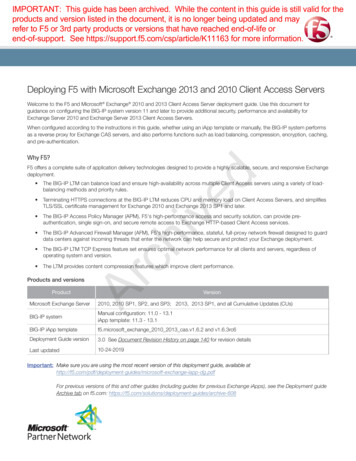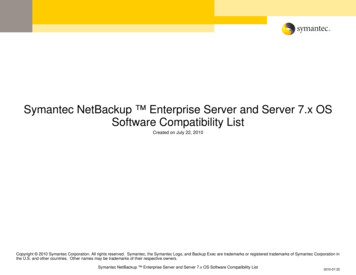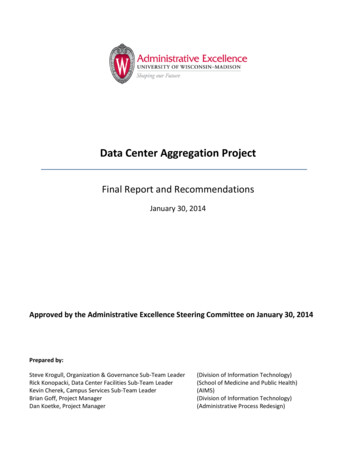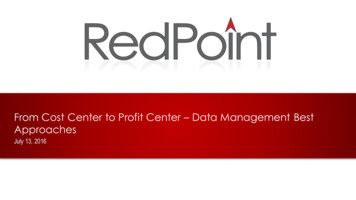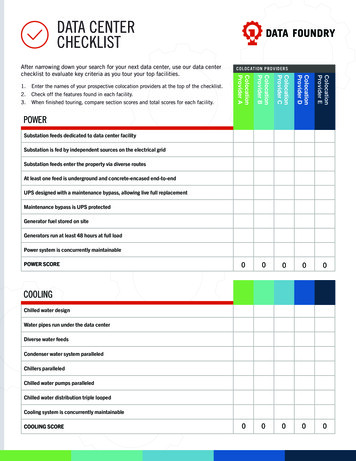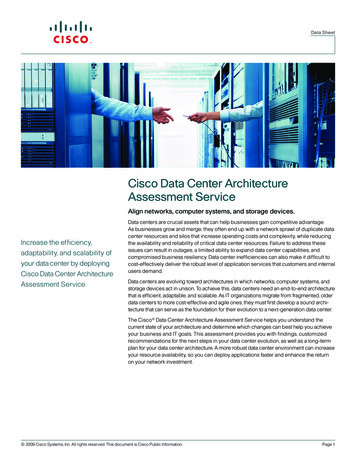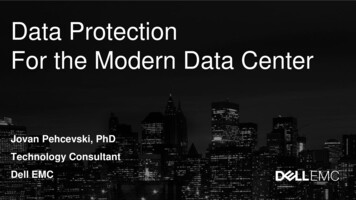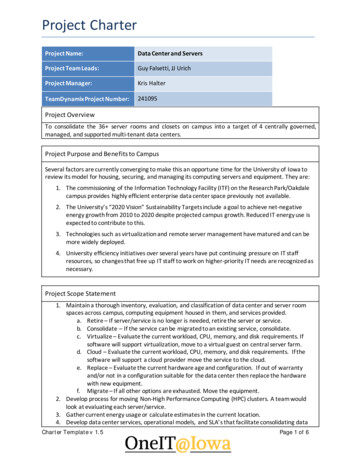
Transcription
Project CharterProject Name:Data Center and ServersProject Team Leads:Guy Falsetti, JJ UrichProject Manager:Kris HalterTeamDynamix Project Number:241095Project OverviewTo consolidate the 36 server rooms and closets on campus into a target of 4 centrally governed,managed, and supported multi-tenant data centers.Project Purpose and Benefits to CampusSeveral factors are currently converging to make this an opportune time for the University of Iowa toreview its model for housing, securing, and managing its computing servers and equipment. They are:1. The commissioning of the Information Technology Facility (ITF) on the Research Park/Oakdalecampus provides highly efficient enterprise data center space previously not available.2. The University’s “2020 Vision” Sustainability Targets include a goal to achieve net-negativeenergy growth from 2010 to 2020 despite projected campus growth. Reduced IT energy use isexpected to contribute to this.3. Technologies such as virtualization and remote server management have matured and can bemore widely deployed.4. University efficiency initiatives over several years have put continuing pressure on IT staffresources, so changes that free up IT staff to work on higher-priority IT needs are recognized asnecessary.Project Scope Statement1. Maintain a thorough inventory, evaluation, and classification of data center and server roomspaces across campus, computing equipment housed in them, and services provided.a. Retire – If server/service is no longer is needed, retire the server or service.b. Consolidate – If the service can be migrated to an existing service, consolidate.c. Virtualize – Evaluate the current workload, CPU, memory, and disk requirements. Ifsoftware will support virtualization, move to a virtual guest on central server farm.d. Cloud – Evaluate the current workload, CPU, memory, and disk requirements. If thesoftware will support a cloud provider move the service to the cloud.e. Replace – Evaluate the current hardware age and configuration. If out of warrantyand/or not in a configuration suitable for the data center then replace the hardwarewith new equipment.f. Migrate – If all other options are exhausted. Move the equipment.2. Develop process for moving Non-High Performance Computing (HPC) clusters. A team wouldlook at evaluating each server/service.3. Gather current energy usage or calculate estimates in the current location.4. Develop data center services, operational models, and SLA’s that facilitate consolidating dataCharter Template v 1.5Page 1 of 6
Project Charter5.6.7.8.9.10.centers spaces. Work to ensure that services provide remote management capability and levelsof support comparable to a local facility.Identify schedule/sequence of server moves and room retirements.In each room, assess the services provided by each server, identify target (move to centralservice, virtualize, or move server) and move services/servers as needed.Identify contingencies as required for services that can’t move and/or perform cost benefitanalysis for possible exemptions.Assessing current data center services and revising and creating new services to address gaps.Transitioning of servers and services to consolidate data centers and server rooms.Decommissioning vacated server rooms so they are ready to be repurposed.Out of scope:1. High performance computing (HPC) clusters.2. College of Medicine managed buildings and rooms.3. UIHC/HCIS managed buildings and rooms.4. Decommissioning of ITF.5. Lift and Shift.High-Level RequirementsReviews of other campuses’ efforts to consolidate data centers indicate that savings and benefits aregenerally achieved in the ways listed below. We recommend that these methods facilitate the approachto optimize the Data Center model at the University of Iowa.1. Most actual ongoing savings is found in virtualizing stand-alone servers (savings in IT stafftime and energy reduction).2. Significant ongoing savings can be found in converting out-of-date and less efficientcomputing equipment to newer and more efficient equipment (savings in energyreductions).3. Additional savings is realized from moving equipment from dispersed or less energy-efficientdata centers to modern, efficient facilities and reducing the number of facilities (savings inenergy, facilities - CRACs, generators, etc - and also in staff time for not managing dispersedfacilities).4. Major non-financial benefits include consistent security standards and managementpractices (reduces institutional risk and staff time via economies of scale and decreasedduplication of effort).5. Life cycle management of equipment.6. Data Centers of the Future – Cloud computing will become more mainstream. Consolidatingserver resources into a “University of Iowa” Cloud Computing environment will allow us futuregrowth and flexibility. Advanced networking between cloud and local data centers will be arequirement of future services.i.Charter Template v 1.5Page 2 of 6
Project CharterHigh-Level Risks Significant up-front costs to either virtualize, buy new equipment or move equipment. Significant labor needed to reconfigure existing services to perform in a virtual environment orremote facility. Potential increase in staff time to travel to central facility for ongoing maintenance andoperations functions (no longer able to simply walk next door to fix a server). Overhead and start-up costs to develop and provide data center services in a more “retail”environment (more procedures and policies are needed to broaden access and usage of a datacenter to serve a variety of campus needs). Flexibility to rapidly deploy equipment or try novel approaches by Colleges, Departments, andResearchers may be adversely impacted. Resistance to change by organizations that house equipment in and manage a local data centeror server room. Fractional Savings – Staffing savings are based on reduction of overall Systems Adminmanagement of servers. If we reduce the workload of a partial staff responsibility but don’treduce the head count then the University will not see all the operational savings. Assumptions and ConstraintsAssumptions: Institutional support for moving faculty/research equipment.Server consolidation breakdowno 25%: Research HPC Clusters -- cannot be virtualized and require replacemento 25%: Application servers that can be consolidated into existing portfolioo 40%: Server workload that can be virtualizedo 10%: Servers that will need to be replaced with physical devicesRe-evaluation of data center access is necessary.Development of necessary ITAR compliance at one or more centrally managed data centers.Constraints: Available funding to replace current non-rack mountable equipment with rack-mountablesystems for data center.Upgrades to building uplinks and/or other networking upgrades to support latency andbandwidth requirements as needed.Server rooms not fully decommissioned may not fully realize forecasted energy, staff and MEPexpense savingsCharter Template v 1.5Page 3 of 6
Project CharterProject GovernanceData Center and Servers Leadership TeamGoal – Overall responsibility to consolidate the 36 data centers on campus down to 4 data centers byJuly 2018. Top Level project team will report up to the CIO’s OneIT steering group. Overall coordination of the Governance Team and the Technical Team. Coordinates the timing of the DC Project Teams. Capital and staffing resource allocation for the DC Project Teams.Data Center GovernanceGoal – An ongoing policy and process focus group with the overall operation of the data centers. Lead by Data Center Manager (Jerry Protheroe). Set the policies for operation of the data centers. Set process for maintaining highly available services in the data center. Coordinates infrastructure maintenance in the data center. Documentation of Service Level Agreements with Technical team. Capacity planning for the data center (power, cooling, floor space and networking fundingmodels, chargeback models, and life cycles of equipment). Ongoing collaboration with Facilities to review the programing on new buildings for serverroom spaces.Data Center TechnicalGoal – Day to day operations of moving services and equipment out of departmental data centers andinto an enterprise class facility. Lead by TBD Evaluation of the services in the data centers and how they would move. Placement of services in appropriate network. Ensuring supportability of hardware that is placed in data center. Working to ensure Governance policies and processes are followed. Documentation of Service Level Agreements with Governance team. Data Center Web site with a service catalog.Data Center Project TeamGoal – Form group around the de-commission of a specific data center or server room. Lead by a member from the Data Center Technical team. Membership would include the Technical group and Local IT Support or technical contact forserver room under consideration SST team or Research Team would be pulled in based on the service being deployed.Data Center Advisor TeamGoal – to get campus input to the process on consolidation Lead by DCS Project Manager (Kris Halter). Input to governance, technical and project teams on SLA’s, life cycle management,funding/charge back models, services, etc Membership would be from a broad representation of campus.Charter Template v 1.5Page 4 of 6
Project CharterNameOneIT Steering CommitteeGuy FalsettiDC OptimizationJJ UrichTechnicalJerry ProtheroeGovernanceKris HalterAdvisorServer Room 1DC Project TeamServer Room 2DC Project TeamServer Room 3DC Project TeamDepartmentDC Project TeamDepartmentDC Project TeamDepartmentDC Project TeamDepartmentDC Project TeamDepartmentDC Project TeamDepartmentDC Project TeamAnticipated Cost Savings CategoriesMEP AnalysisEach of the 36 server rooms were evaluated on Mechanical and Electrical usage. A Power UtilizationEfficiency factor was applied. We then factored staff savings on management of the facilities. Finallywe added any systems to the current data centers as a cost to run that Data Center.Staffing analysisCurrently the ITS Server Support Team manages 487 physical and 1,010 virtual servers with a staff of 19.This gives SST an average of 72 servers per systems administrator. The departmental IT units report 659physical and 487 virtual servers with an effort of 25.3 FTE of effort to manage the systems. The ITSResearch Services team supports 629 servers on two clusters with a staff of 4.Average cost for a Systems Administrator is 100,000 per year.Charter Template v 1.5Page 5 of 6
Project CharterPreliminary MilestonesTarget DateCharter Approval05/01/2015Team Kick off05/31/2015Committee Approval of Project Plan05/31/2015Governance Framework08/31/2015Funding acquired08/31/2015Server Room migrations08/01/2018Close Out08/02/2018Project TeamRoleGuy FalsettiCo-Lead, CoordinatorJJ UrichCo-Lead, Technical Team LeadJerry ProtheroeData Center Governance Team LeadKris HalterAdvisor Team LeadStakeholders:Refer to Stakeholder RegistryPotential Implementation Cost:DC Server Consolidation FY16 - 250KDC Network Aggregation FY16 - 350KDC Facilities FY16 - 280KDC Server Consolidation FY17 - 250KDC Network Aggregation FY17 - 350KDC Facilities FY17 - 280KStaffing, Manager and 2 x Systems Admin - 300KTarget Start Date:05/02/2015Target Close Out Date:Rolling implementation – 08/02/2018 Charter Ratification DateCharter Template v 1.5MM/DD/YYPage 6 of 6
Data Center Web site with a service catalog . Data Ce nter Project Team . Goal – Form group around the de-commission of a specific data center or server room. Lead by a member from the Data Center Technical team . Membership would include the Technical group and Local IT Support or technical contact for server room under consideration SST team or Research Team would be pulled .


